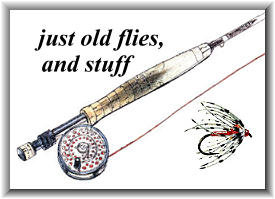"The first Beaverkill fly was tied about 1850 by Harry Pritchard
after an English pattern furnished to him by Judge Fitz James
Fitch, County Judge and Surrogate, 1855-1863, of Greene County,
New York, who named the fly after his favorite stream, the Beaverkill,
in Sullivan County, New York.
It is believed that the English pattern so copied was the Silver Sedge.
Harry Pritchard and his brother Thomas, both formerly of England,
were the sons of Stephen Pritchard, tackle maker, of the market town
of Builth in Brecknochshire, in the Wye River Valley. They were
operating a sporting goods store, a "regular rendezvous for anglers,"
which they had established in 1855 at 50 Fulton Street in New York
City.
Harry Pritchard was one of the finest fly casters of his time, 1875 - 1890.
It was after him that the roll cast was for some time called the Pritchard
cast, because he used it very successfully at a distance flycasting
tournament in 1881. In the execution of the Pritchard cast the fly
does not leave the water except on the roll, nor does it go behind the
caster.
The fly as originally tied was similar to the present male or Mr.
Beaverkill. Mr. Pritchard's pattern called for dressing with a light
body and gilt strip ribbing, brown hackle and mallard wings.
The present dry and more popular pattern of the female or Lady
Beaverkill is of doubtful orgin."
Quoted section from Fly Patterns and Their
Origins, published by Westshore Publications,
Color photo from Forgotten Flies.
We appreciate use permission!
|



